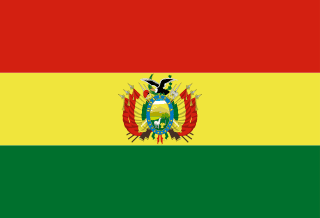Bolivia - Economy

How is the economy of Bolivia? Based on the information we have, Bolivia has a resource-rich economy benefits during commodity booms; has bestowed juridical rights to Mother Earth, impacting extraction industries; increasing Chinese lithium mining trade relations; hard hit by COVID-19; increased fiscal spending amid poverty increases; rampant banking and finance corruption. Key agricultural products in this country include: sugarcane, soybeans, maize, potatoes, sorghum, rice, milk, chicken, plantains, beef (2023).
More about the economy of Bolivia
| Labor force | 6.859 million (2024 est.) |
|---|---|
| Industrial production growth rate | 1.1% (2023 est.) |
| Industries | mining, smelting, electricity, petroleum, food and beverages, handicrafts, clothing, jewelry |
| Population below poverty line | 37.7% (2022 est.) |
| Taxes and other revenues | |
| Fiscal year | |
| Exchange rates | |
| Currency | bolivianos (BOB) per US dollar - |
| Exchange rates 2024 | 6.91 (2024 est.) |
| Exchange rates 2023 | 6.91 (2023 est.) |
| Exchange rates 2022 | 6.91 (2022 est.) |
| Exchange rates 2021 | 6.91 (2021 est.) |
| Exchange rates 2020 | 6.91 (2020 est.) |
| Debt - external | |
| Debt - external 2023 | $11.174 billion (2023 est.) |
| Reserves of foreign exchange and gold | |
| Reserves of foreign exchange and gold 2024 | $1.977 billion (2024 est.) |
| Reserves of foreign exchange and gold 2023 | $1.8 billion (2023 est.) |
| Reserves of foreign exchange and gold 2022 | $3.752 billion (2022 est.) |
| Current account balance | |
| Current account balance 2023 | -$1.15 billion (2023 est.) |
| Current account balance 2022 | $939.084 million (2022 est.) |
| Current account balance 2021 | $1.581 billion (2021 est.) |
| Public debt | |
| Public debt 2017 | 49% of GDP (2017 est.) |
| Budget | |
| Revenues | $11.796 billion (2019 est.) |
| Expenditures | $14.75 billion (2019 est.) |
| Budget surplus (+) or deficit (-) | |
| Remittances | |
| Remittances 2023 | 3.2% of GDP (2023 est.) |
| Remittances 2022 | 3.3% of GDP (2022 est.) |
| Remittances 2021 | 3.5% of GDP (2021 est.) |
| Household income | |
| Lowest 10% | 1.8% (2023 est.) |
| Highest 10% | 31.3% (2023 est.) |
| Average household expenditures | |
| On food | 29.3% of household expenditures (2023 est.) |
| On alcohol and tobacco | 2.2% of household expenditures (2023 est.) |
| Imports | |
| Imports 2023 | $12.988 billion (2023 est.) |
| Imports 2022 | $13.462 billion (2022 est.) |
| Imports 2021 | $10.187 billion (2021 est.) |
| Imports (partners) | China 22%, Brazil 18%, Chile 13%, USA 7%, Peru 5% (2023) |
| Comodities Imports force | refined petroleum, cars, pesticides, trucks, plastics (2023) |
| Exports | |
| Imports 2023 | $12.988 billion (2023 est.) |
| Imports 2022 | $13.462 billion (2022 est.) |
| Imports 2021 | $10.187 billion (2021 est.) |
| Exports (partners) | Brazil 15%, India 13%, China 11%, Argentina 11%, UAE 8% (2023) |
| Comodities Exports force | gold, natural gas, precious metal ore, zinc ore, soybean meal (2023) |
| Real GDP (purchasing power parity) | |
| Real GDP (purchasing power parity) 2024 | $122.2 billion (2024 est.) |
| Real GDP (purchasing power parity) 2023 | $120.531 billion (2023 est.) |
| Real GDP (purchasing power parity) 2022 | $116.927 billion (2022 est.) |
| GDP (official exchange rate) | $49.668 billion (2024 est.) |
| Real GDP Per capita | |
| Real GDP per capita 2024 | $9,800 (2024 est.) |
| Real GDP per capita 2023 | $9,800 (2023 est.) |
| Real GDP per capita 2022 | $9,700 (2022 est.) |
| GDP - composition, by sector of origin | |
| Agriculture | 13.5% (2023 est.) |
| Industry | 24.2% (2023 est.) |
| Services | 51.1% (2023 est.) |
| GDP - composition, by end use | |
| Household consumption | 68.5% (2023 est.) |
| Government consumption | 19.3% (2023 est.) |
| Investment in fixed capital | 17.5% (2023 est.) |
| Investment in inventories | 0.1% (2023 est.) |
| Exports of goods and services | 25.5% (2023 est.) |
| Imports of goods and services | -30.9% (2023 est.) |
| Unemployment rate | |
| Unemployment rate 2024 | 3.1% (2024 est.) |
| Unemployment rate 2023 | 3.1% (2023 est.) |
| Unemployment rate 2022 | 3.6% (2022 est.) |
| Youth unemployment rate (ages 15-24) | |
| Total | 5.2% (2024 est.) |
| Male | 4.8% (2024 est.) |
| Female | 5.8% (2024 est.) |
All Important Facts about Bolivia
Want to know more about Bolivia? Check all different factbooks for Bolivia below.









